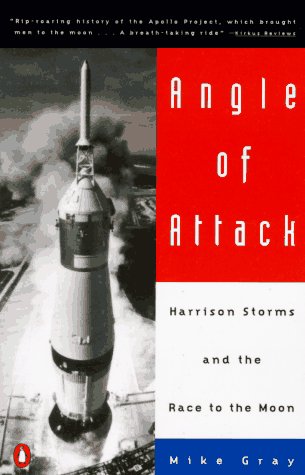

| ANGLE OF ATTACK: Harrison Storms and the Race to the Moon Mike Gray New York: W. W. Norton & Company, 1992 |
Rating: 5.0 High |
|||
| ISBN-13 978-0-393-01892-9 | ||||
| ISBN 0-393-01892-X | 304pp. | HC | $22.95 | |
Harrison Storms was a top-flight engineer and the quintessential corporate man. He drove his people hard, and himself harder, he knew the technology, and he knew how to maneuver around obstacles. After winning North American the Apollo spacecraft contract, he built a mammoth empire and devoted six grueling years to building both the Apollo Command Module and the Saturn rocket's second stage. Then Grissom, White and Chaffee died in the Apollo fire, and Storms became the sacrificial lamb.
This book tells the story of Apollo from Storms' perspective. Some people say it reads too much like a screenplay to be reliable. Mike Gray is a screenwriter (The China Syndrome) and he admits in an Author's Note (page 8) that he first undertook to write a fictional account of the development of the Apollo spacecraft. However, he discovered that the real story was far more fascinating — and that is what he presents here.
The tale begins with astronomer John O'Keefe and his fateful meeting with Wernher von Braun in Huntsville, Alabama during November 1956. The German rocketeer confided to O'Keefe that the Navy's Vanguard rocket, then slated to launch the first artificial satellite the following summer, would be delayed and Russia would steal a march on the U.S. These events happened exactly as predicted. But O'Keefe does not appear again until the final pages, and it appears he is there merely to frame Storms' saga in a larger perspective.
The book does not pretend to be history. Mike Gray clearly admires Harrison Storms and his colleagues, as well as Wernher von Braun and the German rocket team he brought with him from Peënemunde. Nevertheless, Gray has done his homework and created a gripping tale that I could not put down. He has a flair for describing landscapes and the ways people move through them, a gift which resonates well with his subject. He also has a feel for the technology. His coverage of the challenge of constructing the S-2 (Saturn second stage) with its revolutionary common bulkhead is excellent. In writing about the Apollo fire he is a bit on the melodramatic side, and his description of the aftermath of the tragedy clearly reveals his bias for the engineering mind-set, vs. the political. But since I share that bias, I did not mind too much.
Gray presents a host of characters; it is hard to keep them straight. In this, of course, he is merely reflecting the actual events; life does not limit us to a small fixed cast. More troubling is his paucity of dates. He seldom gives a complete date, most often mentioning only the year, and does not stick to a chronological sequence. And I would have liked more of an epilogue. Gray tells us that Storms consulted on the Space Shuttle, but says nothing beyond that.
I noticed only one outright error; others have hinted that there are more. On page 31, he gives Sputnik's apparent magnitude as 14; on page 39 it's risen to 4. There is one curiosity of grammar: "Kennedy symbolized the youthful possibilities of the nation, and suddenly his New Frontier idealism was cut down with a swath that reeked of Machiavellian Old World intrigue." 1
And I found a few typos, in all cases missing words or spaces:
| Page 27: | "He was going give the war effort everything he had..." | |
| S/B: "was going to give". |
| Page 127: | "John Houbolt's worst enemy turned out to Houbolt himself..." | |
| S/B: "turned out to be Houbolt". |
| Page 165: | "Caldwell — he pronouncedit 'Cadwell'..." | |
| S/B: "pronounced it". |
| Page 188: | "...they hadn't been able decide where to put certain mounting brackets..." | |
| S/B: "been able to decide". |
Angle of Attack is a good read and presents a useful description of the aerospace business in general and Apollo in particular.

 To contact Chris Winter, send email to this address.
To contact Chris Winter, send email to this address.